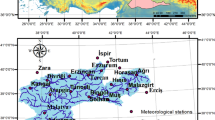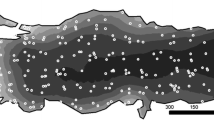Abstract
It is well recognized that statistical linear interpolation models are computationally inexpensive and applicable to any climate data compared to the dynamic simulation method at regional scales. Using five different statistical linear interpolation models, we characterized each model’s performance to predict a climate variable of interest. General linear model, generalized additive model, spatial linear model, and bayesian spatial regression model (BSM) were analyzed. The climate variable of interest was the monthly precipitation, where the spatial variability was explained using terrain information: latitude, longitude, elevation, topographic aspect, and costal proximity. We used the root mean squared error, the mean absolute error and correlation coefficient as the performance. The BSM showed better performance in reflecting the spatial pattern of monthly precipitation compared to the other models. The monthly precipitation and its 95 % prediction interval on a 1 × 1 km grid spacing were generated through a spatial interpolation of 441 point observations.







Similar content being viewed by others
References
Banerjee S, Gelfand AE, Carlin BP (2004) Hierarchical modeling and analysis for spatial data. CRC Press, Boca Raton
Bergant K, Kajfe-Bogataj L (2005) NLS regression as empirical downscaling tool in climate change studies. Theor Appl Climatol 81(1–2):11–23
Betts AK, Chen F, Mitchell K, Janjic ZI (1997) Assessment of the land surface and boundary layer models in two operational versions of the NCEP Eta model using FIFE data. Mon Wea Rev 125:28962916
Busuioc A, Tomozeiu R, Cacciamani C (2008) Statistical downscaling model based on canonical correlation analysis for winter extreme precipitation events in the Emilia-Romagna region. Int J Climatol 28(4):449–464
Chatterjee S, Price B (1997) Regression analysis by example. Wiley, New York
Christensen JH, Carter TR, Rummukainen M, Amanatidis G (2007) Evaluating the performance and utility of regional climate models: the PRUDENCE project. Clim Change 81(1):1–6
Clifton P, Neuman S (1982) Effects of kriging and inverse modeling on conditional simulation of the Avra Valley aquifer in souther Arizona. Water Resour Res 18(4):1215–1234
Cressie NAC (1993) Statistics for spatial data, 2nd edn. Wiley, New York
Finley AO, Banerjee S, Carlin BP (2007) spBayes: an R package for univariate and multivariate hierarchical point-referenced spatial models. J Stat Softw 19(4):1–24
Guisan A, Edwards TC Jr, Hastie T (2002) Generalized linear and generalized additive models in studies of species distributions: setting the scene. Ecol Model 157(2):89–100
Hastie TJ, Tibshirani RJ (1990) Generalized additive models. Chapman & Hall/CRC, London
Hong K-O, Suh M-S, Rha D-K, Chang D-H, Kim C, Kim M-K (2007) Estimation of high resolution gridded temperature using GIS and PRISM. Atmosphere 17(3):255–268
Hong Y, Nix H, Hutchinson M, Booth T (2005) Spatial interpolation of monthly mean climate data for China. Int J Climatol 25:1369–1379
Huth R (2004) Sensitivity of local daily temperature change estimates to the selection of downscaling models and predictors. J Climate 17(3):640–652
Jeong DI, St-Hilaire A, Ouarda TBMJ, Gachon P (2012) Comparison of transfer functions in statistical downscaling models for daily temperature and precipitation over Canada. Stoch Env Res Risk Ass 26(5):633–653
Kang EL, Cressie N, Sain SR (2012) Combining outputs from the North American regional climate change assessment program by using a Bayesian hierarchical model. J Roy Stat Soc 61(2):291–313
Kang H, Park CK, Hameed SN, Ashok K (2009) Statistical downscaling of precipitation in Korea using multimodel output variables as predictors. Mon Weather Rev 137(6):1928–1938
Kim JP, Kim G, Lee WS (2012a) Estimation of monthly areal precipitation using Daymet and PRISM. J Korean Soc. Hazard Mitig 12(5):83–90
Kim M-K, Han M-S, Jang D-H, Baek S-G, Lee W-S, Kim Y-H, Kim S (2012b) Production technique of observation grid data of 1 km resolution. J Clim Res 7(1):55–68
Koster RD, Suarez MJ, Heiser M (1999) Variance and predictability of precipitation at seasonal-to-interannual timescales. J Hydrometeorol 1:26–46
Lee Y, Yoon S, Murshed MS, Kim MK, Cho CH, Baek HJ, Park JS (2013) Spatial modeling of the highest daily maximum temperature in Korea via max-stable processes. Adv Atmos Sci 30(6):1608–1620
Liu W, Fu G, Liu C, Song X, Ouyang R (2013) Projection of future rainfall for the North China plain using two statistical downscaling models and its hydrological implications. Stoch Env Res Risk Ass 27:1783–1797
Lu G, Wong D (2008) An adaptive inverse-distance weighting spatial interpolation technique. Comput Geosci 34(9):10441055
McCullagh P, Nelder J (1989) Generalized linear models, monographs on statistics and applied probability, 2nd edn. Chapman & Hall, New York
Mendes JM, Turkman KF, Corte-Real J (2006) A Bayesian hierarchical model for local precipitation by downscaling large-scale atmospheric circulation patterns. Environmetrics 17(7):721–738
Miller J, Franklin J (2002) Modeling the distribution of four vegetation alliances using generalized linear models and classification trees with spatial dependence. Ecol Model 157:227–247
Oh JH, Kwon WT, Ryoo SB (1997) Review of the researches on Changma and future observational study (KORMEX). Adv Atmos Sci 14(2):207–222
Park JS, Baek J (2001) Efficient computation of maximum likelihood estimators in a spatial linear model with power exponential covariogram. Comput Geosci 27(1):1–7
Park JS, Kang HS, Lee YS, Kim MK (2011) Changes in the extreme daily rainfall in South Korea. Int J Climatol 31(15):2290–2299
Park N-W, Jang D-H (2008) Mapping of temperature and rainfall using DEM and multivariate kriging. J Korean Geogr Soc 43(6):1002–1015
Robertson G (1987) Geostatistics in ecology: interpolating with known variance. Ecology 68(3):744–748
Roustant O, Ginsbourger D, Deville Y (2012) DiceKriging, DiceOptim: two R package for the analysis of computer experiments by kriging-based metamodeling and optimization. J Stat Softw 51(1):1–55
Skourkeas A, Kolyva-Machera F, Maheras P (2010) Estimation of mean maximum summer and mean minimum winter temperatures over Greece in 2070–2100 using statistical downscaling methods. Euro Asian J Sustain Energy Dev Policy 2:33–44
Tareghian R, Rasmussen PF (2013) Statistical downscaling of precipitation using quantile regression. J.Hydrol 487:122–135
Thornton PE, Running SW, White MA (1997) Generating surfaces of daily meteorological variables over large regions of complex terrain. J Hydrol 190(3):214–251
Tolika K, Maheras P, Vafiadis M, Flocas HA, Arseni-Papadimitriou A (2007) Simulation of seasonal precipitation and raindays over Greece: a statistical downscaling technique based on artificial neural networks (ANNs). Int J Climatol 27(7):861–881
Wilks DS (2011) Statistical methods in the atmospheric sciences. Academic Press, New York
Wood SN (2006) Generalized additive models: an introduction with R. Chapman & Hall/CRC, Boca Raton
Wood S (2010) mgcv: GAMs with GCV/AIC/REML smoothness estimation and GAMMs by PQL. Available via. http://cran.r-project.org/package=mgcv. Accessed 17 Dec 2014
Wood S (2011) Fast stable restricted maximum likelihood and marginal likelihood estimation of semiparametric generalized linear models. J R Stat Soc 73(1):3–36
Yihui D, Chan JC (2005) The East Asian summer monsoon: an overview. Meteorol Atmos Phys 89(1–4):117–142
Zhu CW, Park CK, Lee WS, Yun WT (2008) Statistical downscaling for multi-model ensemble prediction of summer monsoon rainfall in the Asia-Pacific region using geopotential height field. Adv Atmos Sci 25(5):867–884
Acknowledgments
The authors would like to acknowledge to Prof. Sujit K. Sahu at Mathematical Science, University of Southampton, for his valuable advices about the Bayesian spatial regression model and spBayes package. We thank reviewers for their constructive and helpful comments on this paper. This research was supported by Basic Science Research Program through the National Research Foundation of Korea (NRF) funded by the Ministry of Education, Science and Technology (NRF-2014R1A1A2009060). It was also supported by a Grant (CATER-2012-3082) from the Korea Meteorological Administration Research and Development Program.
Author information
Authors and Affiliations
Corresponding author
Rights and permissions
About this article
Cite this article
Yoon, S., Kim, MK. & Park, JS. Comparison of statistical linear interpolation models for monthly precipitation in South Korea. Stoch Environ Res Risk Assess 29, 1371–1382 (2015). https://doi.org/10.1007/s00477-015-1031-7
Published:
Issue Date:
DOI: https://doi.org/10.1007/s00477-015-1031-7




